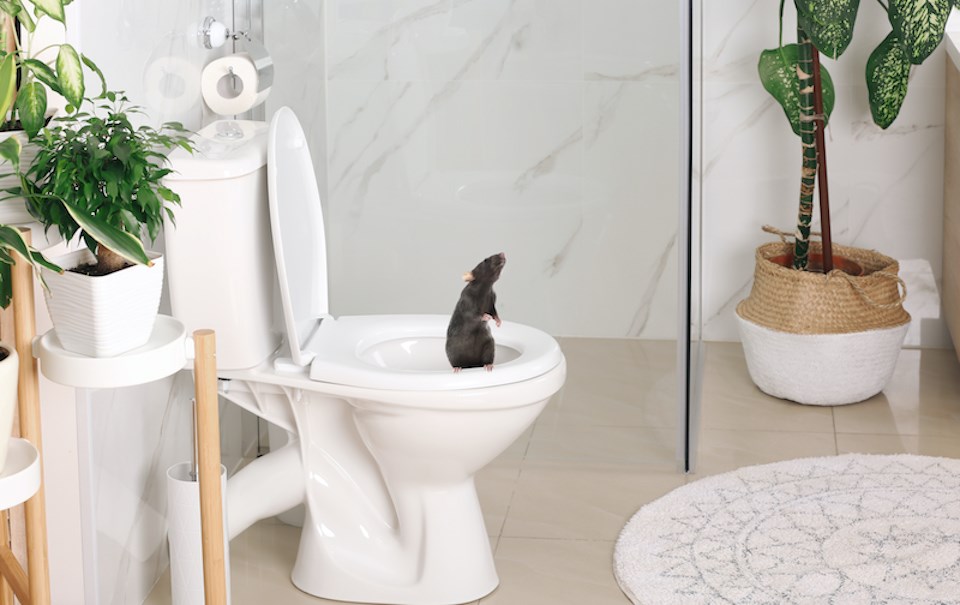Imagine sitting down on the toilet and getting bitten by a rat.
While it might seem the stuff of nightmares, a 76-year-old Montreal man was hospitalized after a rodent bit while he attempted to remove it from his toilet. He experienced medical issues related to the incident just shy of three weeks later, according to Live Science.
Mike Londry, owner of Vancouver-based Westside Pest Control, says pests thrive in humid conditions with access to food and shelter, making bathrooms an ideal environment.
The pest control expert hasn't encountered rats in toilets on any jobs in Metro Â鶹´«Ã½Ó³»but says they will certainly hop in and out of them.
Rats can hold their breath for three minutes underwater and tread water for an astonishing three days, making them expert sewer navigators. They also don't mind having their bodies pressed tightly against surfaces, meaning they don't feel uncomfortable crawling through water pipes. They have receptors on their bodies that provide cues that they are safer when they come in contact with something, explains Londry.
But it is a more likely scenario that rodents climb into toilets to get a drink of water than that they've crawled up through the pipes.
"Rats are incredible swimmers and it's not impossible for them to emerge but it is more likely they cling to the inside of a bowl to get a drink of water," he notes.
"But unless someone just flushed the better part of a steak dinner down the drain they aren't going down there."
Rodents are not the only pests that enjoy getting a drink - or food - from toilet bowls.
Which Metro Â鶹´«Ã½Ó³»pests love bathrooms and toilets?
Londry says plaster beetles, known as bathroom beetles, congregate around toilets and feast on fungi and other mould spores. They are about the size of a watermelon seed and are attracted to humid conditions. The best way to prevent an infestation is to keep bathrooms clean and reduce humidity.
"Most pests are attracted to moisture and humidity. They need food, water, and shelter," he notes. "Bathrooms offer water via the condensation."
Londry says bathrooms without proper circulation or fans become breeding grounds for a host of creepy crawlies, most notably silverfish. About 90 per cent of calls to Westside about bathrooms are about the silvery, wingless insects.
"They have thrived in these environments for 330 million years. They aren't going anywhere anytime soon," he notes, adding they reproduce in high humidity over 60 per cent.
Turning on fans can reduce the spread or kill the insects. Londry once eliminated a pest problem in his own bathroom by keeping a fan on for 16 hours a day until the pests all perished. A humidifier will also reduce favourable breeding conditions.
Silverfish can also be killed in sticky traps because they tend to travel closely along walls.
Londry lived in an old Kitsilano apartment with an extensive silverfish infestation when he was young.
"Anytime I would go to turn on the light -- [the floor being] alive is maybe an exaggeration -- but at least a dozen big silverfish would be scurrying from my feet," he recalls.
Londry has also seen some impressive carpenter ant infestations in bathrooms. In one case, he had to get on a stepladder and blast aerosol on a skylight and was covered by what he describes as a "waterfall of carpenter ants" falling from the rotten wood.
People should also keep their eye on organic matter building up in drains. Drain flies lay their eggs in this material and can quickly thrive; their larvae look like tiny black worms. They can also also live in toilets where decaying matter builds up.
People can remove build-up in drains with a flexible scrub brush that can get deep into the drain.
People with major silverfish issues can also use Diatomaceous earth around the edges of their bathroom. The powder is comprised of sediment from fossilized algae and kills the pests. However, it shouldn't be used in homes with crawling children or pets.



